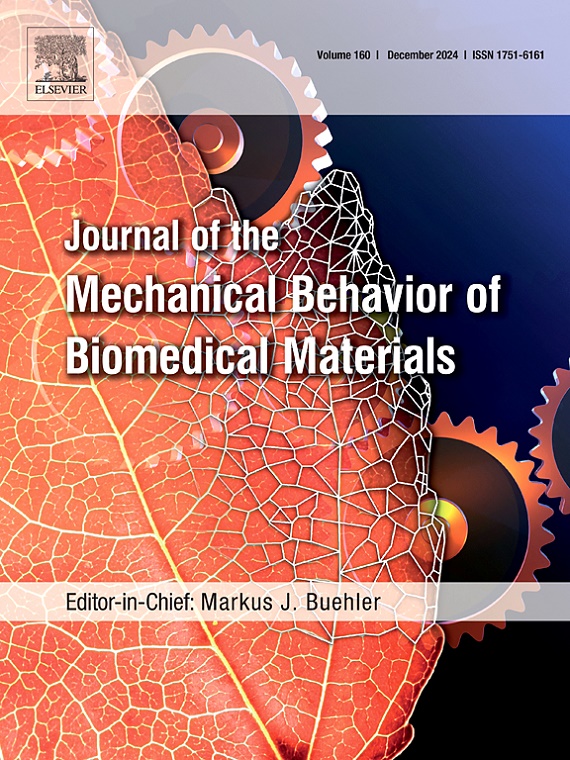颞下颌关节椎间盘复位手术中氧化锆锚钉的SLA-3D打印及生物活性增强。
IF 3.3
2区 医学
Q2 ENGINEERING, BIOMEDICAL
Journal of the Mechanical Behavior of Biomedical Materials
Pub Date : 2025-01-13
DOI:10.1016/j.jmbbm.2025.106897
引用次数: 0
摘要
提出了一种用于颞下颌关节盘复位手术的氧化锆陶瓷锚钉3D打印和增强其表面生物活性的方法。最初,通过应用SLA-3D打印技术解决了精细陶瓷锚钉的脆性和加工困难带来的挑战。这允许对打印锚钉的成形精度和生物力学特性进行探索。研究发现,3D打印氧化锆螺钉螺纹加工的尺寸偏差约为100 μm。当螺纹段长度为7.0 mm时,直径为2.7 mm的3D打印氧化锆锚钉与直径为2.0 mm的钛螺钉相比,其最大轴向拉力为102.91 N。氧化锆锚钉最大垂直拉力超过锚钉缝线断裂力21.03 N,满足临床应用要求。此外,ZrO2-PDA-La3+复合生物涂层的应用增强了3D打印氧化锆锚钉的表面生物活性。PDA在植入过程中保证了生物涂层的可靠粘附,而La3+则显著提高了氧化锆陶瓷表面的成骨能力,从而有助于种植体的长期稳定性。最终,在力学性能和生物活性方面满足基本临床要求的氧化锆锚钉被成功开发,为ADDwoR患者,特别是金属过敏患者提供了一种新的治疗选择。本文章由计算机程序翻译,如有差异,请以英文原文为准。
SLA-3D printing and bioactivity enhancement of zirconia anchor screws for temporomandibular joint disc reduction surgery
A method is proposed for 3D printing and enhancing the surface bioactivity of zirconia ceramic anchor screws, specifically tailored for temporomandibular joint disc reduction surgery. Initially, the challenge posed by the brittleness and processing difficulties of fine ceramic anchor screws was addressed through the application of SLA-3D printing technology. This allowed for an exploration of the forming accuracy and biomechanical properties of the printed anchor screws. According to research findings, the dimensional deviation in the thread processing of 3D printed zirconia screws is approximately 100 μm. When the threaded segment measures 7.0 mm in length, the 3D printed zirconia anchor screw, with a diameter of 2.7 mm, demonstrates comparable maximum axial tensile forces 102.91 N to a titanium screw of 2.0 mm diameter. The maximum vertical tensile force of the zirconia anchor screws exceeds the breaking force of the anchor suture by 21.03 N, fulfilling the requirements for clinical application. Additionally, the application of a ZrO2-PDA-La3+ composite biological coating enhances the surface bioactivity of the 3D printed zirconia anchor screws. PDA ensures reliable adhesion of the biological coating during the implantation process, while La3+ significantly boosts the osteogenic capacity of the zirconia ceramic surface, thereby contributing to the long-term stability of the implant. Ultimately, zirconia anchor screws satisfying basic clinical requirements in terms of mechanical properties and biological activity were successfully developed, offering a novel treatment option for ADDwoR patients, particularly those with metal allergies.
求助全文
通过发布文献求助,成功后即可免费获取论文全文。
去求助
来源期刊

Journal of the Mechanical Behavior of Biomedical Materials
工程技术-材料科学:生物材料
CiteScore
7.20
自引率
7.70%
发文量
505
审稿时长
46 days
期刊介绍:
The Journal of the Mechanical Behavior of Biomedical Materials is concerned with the mechanical deformation, damage and failure under applied forces, of biological material (at the tissue, cellular and molecular levels) and of biomaterials, i.e. those materials which are designed to mimic or replace biological materials.
The primary focus of the journal is the synthesis of materials science, biology, and medical and dental science. Reports of fundamental scientific investigations are welcome, as are articles concerned with the practical application of materials in medical devices. Both experimental and theoretical work is of interest; theoretical papers will normally include comparison of predictions with experimental data, though we recognize that this may not always be appropriate. The journal also publishes technical notes concerned with emerging experimental or theoretical techniques, letters to the editor and, by invitation, review articles and papers describing existing techniques for the benefit of an interdisciplinary readership.
 求助内容:
求助内容: 应助结果提醒方式:
应助结果提醒方式:


